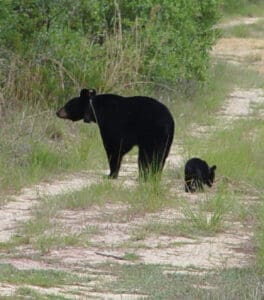By Jamie Zimchek
 It’s nearly midnight. Suddenly, there’s the sort of crash outside that gives a person heart palpitations. Prowling cautiously around the corner, you spot the furry culprit lumbering leisurely down the back road with a trash bag in tow: it’s your friendly neighborhood Florida black bear, and he’s just found dinner. Yes, by tomorrow morning it will probably be a shredded mess in the woods to clean up, but no, there’s no cause for panic, according to Dave Telesco, Bear Management Program Coordinator for the state of Florida. “I just hate hearing someone was afraid to go outside,” he says. “Hollywood films are not reality. Florida black bears are not interested in people, and most are easily scared away.”
It’s nearly midnight. Suddenly, there’s the sort of crash outside that gives a person heart palpitations. Prowling cautiously around the corner, you spot the furry culprit lumbering leisurely down the back road with a trash bag in tow: it’s your friendly neighborhood Florida black bear, and he’s just found dinner. Yes, by tomorrow morning it will probably be a shredded mess in the woods to clean up, but no, there’s no cause for panic, according to Dave Telesco, Bear Management Program Coordinator for the state of Florida. “I just hate hearing someone was afraid to go outside,” he says. “Hollywood films are not reality. Florida black bears are not interested in people, and most are easily scared away.”
If you have a Ring doorbell, or some other security camera system, it’s quite likely that you’ve already captured a shot of one of these large mammals (or know someone who has). Telesco notes that their population is, in fact, slowly increasing (females normally only have two cubs every other year), and this is bear country. But the fact that we’re seeing more of them has to do in part with the fact that more homes have security cams, and more people spent time at home during the current pandemic. Additionally, area development has in some areas reduced their habitat, forcing them into increasingly populated areas. Furthermore, Fall is when bears are more active. “This time of year with the cooler mornings and evenings, the bears are starting to get ready for winter,” explains Telesco. “Pregnant females do hibernate because their cubs are born during February, so they have to stay put for a good three months before they’re mobile.” Males don’t have to den up, but are still working to build up fat. That way, if there’s a cold snap, they can hunker down for a couple of weeks without having to eat or drink.
Bears need as much as 20,000 calories a day, and normally, 73% of their diet is plants. This means when weighing the advantages of eating many, many acorns at four-calories each versus a few bags of trash, some bears are going to go for trash every time. “They’re smart enough to be lazy,” says Telesco with a laugh. This translates into long daily active periods of up to 18 hours, though they try to stay nocturnal for neighborhood raids to avoid human contact. In the wild, he explains, they’d be more active at dawn and dusk. Black bears aren’t territorial either, so if you get repeat sightings, it may or may not be the same bear. Depending on the population, a male may roam over 100 square miles, while females tend to stay within a 20 square mile area. How many miles can they cover in a day? “That depends on time of year. The most they’re moving is now. They’re so plant oriented, they know when the galberries are going to be ripe and where,” elaborates Telesco. “It just depends on what food source they’re trying to get to.” One bear study documented bears moving anywhere from 0.6 to 1.2 miles a day in the Fall.
Right now, Panama City Beach is traversed by two growing bear populations: Eglin from the east and Apalachicola from the west, which makes this region a busy sleuth of bear activity. However, that is not a cause for alarm. According to statistics available on the myfwc.com website, only 1% of all calls in northwest Florida between 2010 and 2020 were for reasons of bear-related public safety; even fewer were related to bears entering a structure.
Usually they are easily scared away by beeping a car alarm, or hand clapping. “They’re really uncomfortable around us,” says Telesco. And with a sense of smell 2,100 times more powerful than a human sniffer, they can detect scents over a mile away, which means they’re usually quick to smell humans and beat a hasty retreat. Bears have been known to get aggressive around dogs, so it’s wise to avoid that kind of interaction by keeping you dog close on a non-retractable leash, but their relationship with cats is more complicated: there are many documented cases of cats treeing black bears (do a search for “cats chasing bear videos” if you want to see this for yourself). Still, if you leave food out for local cats, it’s better to pull that every evening to avoid appetizing smells bringing in bears and other wildlife for their midnight snacks.
Wondering about the age of your local bear? Telesco explains that it’s possible to get a good gauge on a bear’s age by checking its ear size in relation to its body – a bear’s ear size doesn’t change after it’s a year old, so younger bears tend to have more “Mickey-mouse” ears, as well as lankier, puppy-like limbs. When a female gets ready to breed every other year, she kicks any male offspring out as an incoming adult male will kill the younger males; female cubs aren’t seen as the same kind of threat, so they tend to set up a home range near their mothers. This means that in any given Autumn, there may be a higher percentage of juvenile males trying to get their “bearings.” You might not ever spot one, but dumped bird feeders, tipped trash cans (and claw marks down the front of your can) are fairly good indicators that there’s a bear presence in your neighborhood. Bears will return to a spot if they’ve found it to be a good food source in the past, so to avoid repeat visits, there are some things to try. For one, a bird feeder needs to be suspended at least 10 feet up, between two trees (far enough away from the trunks that the bear can’t reach it by climbing). Trash is usually the biggest concern however, and though there are plenty of bear-proofing tips out there, they’re not a one-size fits all solution. Many local trash companies will allow customers to retrofit their trash receptacles with latches, clamps, or other tie-downs (but have to be left unlatched on pick-up day). You can find directions for these at the websites listed below. Others advise freezing leftover food and tossing it last minute, or doing double-duty with the garbage disposal rather than throwing it away (much to the dismay of plumbers everywhere). Keeping trash in a garage or secure shed is another option until the morning or pick up instead of the night before so bears don’t treat your yard as the best drive-through around. Some even recommend putting ammonia in the trash, although Telesco notes that this might work for some bears but not others. “We had a father and son peeing every night on their garbage can – I’m not going to recommend that,” he laughs.
For more information on fostering healthy human-bear relations, visit bearwise.org, a website used by all 15 states in the Southeast, and MyFWC.com/Bear.





















































